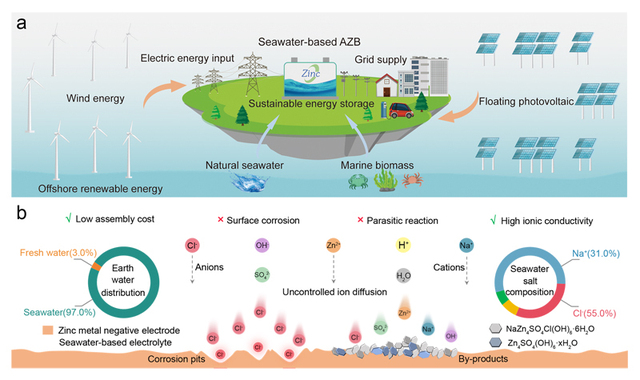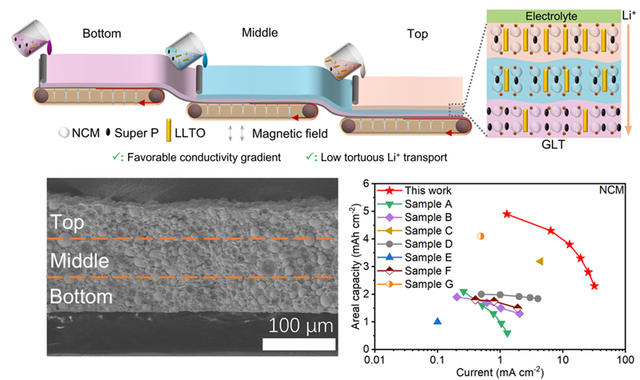Recently, the research team led by Professor Jingyi Wu from the School of Materials Science and Engineering at Ocean University of China, in collaboration with Professor Guihua Yu from The University of Texas at Austin, has made significant advancements in the field of next-generation rechargeable batteries. Their findings were published in two prestigious journals: Nature Communications and Angewandte Chemie International Edition
Pairing seawater electrolytes with zinc metal anodes has emerged as a promising sustainable solution for large-scale marine energy storage due to its inherent safety, ultra-low cost, and infinite water resources. However, stabilizing zinc metal anodes in seawater electrolytes remains a significant challenge because of chloride ions and complex cations in seawater. The research team first revealed that chloride-induced pitting corrosion initiates anode degradation and exacerbates dendrite growth, leading to rapid battery failure. To address this, they proposed a charge gradient interface strategy to regulate ion transport at the interface, which simultaneously suppresses chloride accumulation on the zinc anode surface and accelerates zinc-ion diffusion. This promotes uniform zinc deposition and mitigates corrosion and side reactions, extending the zinc anode lifespan by 40 times.The seawater-based zinc-ion full battery achieves an areal capacity of 5 mAh cm⁻² and stable operation over 500 cycles. This work provides a viable guideline for stabilizing zinc metal anodes in seawater electrolyte systems and constructing sustainable seawater-based energy storage devices. The innovative study, titled All-natural charge gradient interface for sustainable seawater zinc batteries, was recently published in Nature Communications. The first contributing institution is the School of Materials Science and Engineering at Ocean University of China, with Fan Wenjie, a 2022 Ph.D. candidate, serving as the first author.

Figure 1 Schematic of Application Scenarios and Corrosion Mechanism for Seawater Zinc Batteries
In solid-state batteries, unlike fully infiltrated liquid electrolytes, solid-state electrodes lack fast ion transport pathways, exhibiting low-throughput solid-phase ion diffusion. This results in significantly lower electrode loading (energy density) and charging rates (power density) compared to liquid batteries. Based on ion transport mechanisms in solid-state electrodes, the research team proposed a low-tortuosity gradient conductive electrode structure design to enhance ion transport efficiency and balance ion concentration gradients, thereby overcoming kinetic limitations. This design achieved rapid charging capability in practical electrodes, delivering a room-temperature areal capacity of 3.3 mAh cm⁻² at a 3C current density. This innovation provides a promising pathway for developing high-energy/power density solid-state batteries.The study, titled Gradient Design with Low-tortuosity Overcoming Kinetic Limitations in High-Loading Solid-State Cathodes, was recently published in Angewandte Chemie International Edition. The first contributing institution is the School of Materials Science and Engineering at Ocean University of China, with Cheng Guangzeng, a 2022 Ph.D. candidate, serving as the first author.This work was supported by the Taishan Scholars Program of Shandong Province and the Basic Scientific Research Funds for Central Universities.

Figure 2 Schematic of Fabrication for Low-Tortuosity Gradient Electrode and Comparison of Electrochemical Performance
The research team led by Prof. Jingyi Wu has made significant progress in designing novel composite materials and their applications in next-generation rechargeable batteries. By leveraging the zincophilic properties of single metal atoms and their charge polarization effects, the team dynamically regulated microspace electric fields at the anode interface, providing a simple yet efficient strategy for stabilizing zinc metal anodes. Their findings, titled Atomic Zincophilic Sites Regulating Microspace Electric Fields for Dendrite-Free Zinc Anode, were published in the internationally renowned journal Advanced Materials. Team Develops Magnetic Field-Induced Vertical Alignment of Ceramic Nanowires for High-Performance All-Solid-State Cathodes.Using a magnetic field-induced method, the research team controlled the vertical alignment of ceramic fast-ion conductor nanowires within solid-state cathodes, enabling rapid ion transport and high energy density in batteries. Their work, titled Efficient Ion Percolating Network for High-Performance All-Solid-State Cathodes, was published in the top-tier journal Advanced Materials. Team Proposes Low-Tortuosity Composite Solid-State Electrolyte with Vertical Ion Transport Channels.The research team also developed a low-tortuosity composite solid-state electrolyte strategy, enabling rapid ion transport through vertical ion transport channels. Their study, titled Composite Solid-State Electrolyte with Vertical Ion Transport Channels for All-Solid-State Lithium Metal Batteries, was published in the internationally renowned journal Small.
Corresponding Author: Jingyi Wu

Group photo of Prof. Jingyi Wu’s research group (back row, middle position)
Article Link: https://doi.org/10.1038/s41467-025-56519-0
https://doi.org/10.1002/anie.202425357


